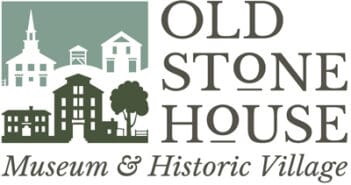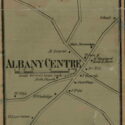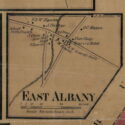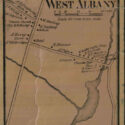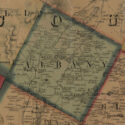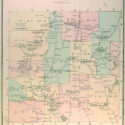Town Facts
- Charter granted: 1782, to Col. Henry E. Lutherloh (or Lutterloh), Maj. Thomas Cogswell, and their associates
- Surveyed: 1788
- Town government organized: 1806
- Original name: Lutterloh, until 1815
- First church organization: Congregational, 1818
- First road: Bayley-Hazen military road, 1779
- First gristmill: 1820, Jesse Rogers (Rogers also operated a hotel).
- First sawmill: ca. 1820, John Culver
- First woolen mill: 1820s, Jabez Page
- Large amount of smuggling in the area around 1813.
- Noticeable population growth in 1830s.
- Starch factory in East Albany ca. 1870
- Congregationalists built a church in the center of town in 1841, which burned in 1846. Bought share of the Baptist church building, then built a new church in 1868. Also “Free-Willers,” Episcopal Methodists, and Wesleyan Methodists (who broke from the latter, apparently in regard to the slavery question). St John of the Cross Roman Catholic Church organized in 1874, although the first Mass was celebrated in 1840. The majority of early Catholics in Albany were Irish farmers. Only two church were left in Albany in 1976.
Albany
From the Vermont Historical Gazetteer, edited by Abby Maria Hemenway. Orleans County – Albany Chapter: By Norris M. Darling. Published by Claremont Manufacturing Co, 1877. Pgs 47-54
The charter of this township was granted to Col. Henry E. Lutherloh and Maj. Thomas Cogswell and their associates. Granting to them the ancient and honorable township of Lutterloh-the same being 6 miles square-reserving five equal shares for specific purposes therein named. The outlines of the town were surveyed out, and the corners noted Sept 23 and 24, 1788.
The conditions of this charter are as follows:
-That each proprietor of the township, his heirs or assigns, shall plant or cultivate five acres of land, and build a house at least 18 feet square on the floor, or have one family settle on each respective right or share of land, within one term of four years from the time the out lines of said township shall be known and established
as the law directs-on penalty of the forfeiture of each respective right or share of land in said township, not so improved or settled, and the same to revert to the freemen of this State, to be by their representatives -granted to such persons as shall appear to settle and cultivate the same. In testimony whereof we have caused the Seal of the State to be affixed, this 26th day of June, A. D. Seventeen Hundred and Eighty-two, in the sixth year of our Independence.
By his Excellency’s command,
Joseph Fay, Sec’y.
THOS. CHITTENDEN.
The liability to loss and forfeiture of rights in this town, served materially to retard its settlement. Disputed titles, and a partial survey, operated to drive away some that would have staid. The want of schools for their children prevented many from coming into town. The few inhabitants, and scattered locale of the few, made it impracticable to have schools at this stage of the town’s history: for it is a matter of history, that the centre, and almost every corner of this town were taken up about the same time, and when the population did not exceed 10 or 15 families, nearly all quarters of the township were being settled.
The town of Lutterloch (now Albany,) was organized March 27, 1806. The first record of births was as follows: “Cynthia Neal, daughter of Benj. and Lucy Seal, borne Feb. 18, 1804: Augusta Neal. Borne May 29, 1805: Anny Neal, borne June 27, 1806. Attest, Benj. Neal, Town Clark.” The first record of Deaths is as follows: “Died, at Lutterloh, July 25th, 1808. Anny Neal, daughter of Benj. and Lucy Neal aged two years and one month-and Orpha Gale, aged two years and seven mouths.”
At this time in 1816, I find the name of Stephen Corey, the owner of the first, and for a long time, the only mill in town-a respectable citizen and the father of Dr. Simeon B. Corey, now of Craftsbury. There was not only an increase in population, the whole number being 253, but there is an increase of the grand-list, which this year amounts to $2, 750. There is also a general appearance of thrift since the war and the cold seasons of 1816 and 1817, individual grand-lists having nearly doubled, and the aggregate nearly quadrupled. During the next 2 years, large numbers were added to the number of freemen.
There is still another circumstance connected to the [Corey] family, that at the time proved to be a singular, natural (perhaps) curiosity. It is said of Mrs. Corey, that at the age of 25 or 30 years, she was small of stature, slim and delicate, and withal, good looking. But about this time, or a little later in life, she commenced to grow- regularly she gained. When first apprised of the fact, she would abstain
from food till almost famished with hunger, with a view to stop it, but all to no purpose. Her physicians informed her that it was useless to try to starve it down. She grew tall and large; even the nose of her face assumed huge dimensions, and her hands- no man in town had such a pair of hands as hers: and this growth continued to the end of life. She was more than 6 feet tall, and of a large frame, though thin of flesh. She lived several years in this way, laboring hard all of the time. She died about 1838.
About this time Cha’s and Millen Seaver, then young men, proposed to present the town with a public common, located near the then center of business in town, and near the geographical center of the town. This liberal proposal was finally accepted, and a townhouse erected on or near the same. The building of this house was put in specifications and let to the lowest bidder. It appears that John Culver took the contract to build the same, for $389.00. It also appears he did not build, or at least, finish this house, for subsequently we find the town voting as to dimensions altering its size from 30 by 30 feet, to 30 by 33. This last vote was taken March 13. 1823.- Jan. 13, 1824, at a meeting “called to see what the town would do in regard to accepting the town-house,” provided Mr. Corley will give competent bonds that the house shall be completed by the first day of June next.” At this meeting it was voted “To accept the house, provided Mr. Corley gets it done by the first day of June.”
Among the arrivals this year was also the Rev. Elias W. Kellog. Mr. K. at this time was a very acceptable preacher of the Congregational order. He was ordained January 1827, and in March following was elected town clerk, in place of John B. Putnam, who had so long and so well fulfilled the responsibilities of this important office. This year was added likewise to the list, John Paine, Jr., who bought a farm upon the river, and still lives on the same farm, and is among the wealthiest farmers in town. Jonathan Fitz, who came here from Craftsbury and commenced the business at tanning at Albany Centre, and continued his business, in connection with the boot and shoe business, by himself or with his sons while he lived. Soon after his death the old place was sold out, and the business of manufacturing leather in town abandoned. Mr. Fitz was for many years postmaster here.
About this time we also find the name of Simeon S. Hovey, so long the popular schoolteacher of this and surrounding towns. Mr. Hovey was a practical surveyor, and lines and roads surveyed by him were called all right.
Roads had been laid out, and made, centering into the different places of business. School districts bad been organized, and school houses built. Small farms, full of stumps, dotted every section of the town. Log cabins or small houses were very common, especially on the river road. There was occasionally a good house and out-buildings, but they were few and far between. No rich old charterman occupied a prominent position among the denizens of Lutterloh or Albany. Col. Lutterloh who gave the charter name to the town, was either too poor, or else unwilling to pay the charter expenses, and consequently lost his chance to monopolize the larger proportion of the proprietors’ rights, and by that means control the public affairs.
Equality and independence seem to have been the general characteristics of the early Albanians. Scarcely a family came into town from the date of the organization till 1820, but what was peremptorily ordered to depart from the town with their family. Property or respectability was of no account. The selectmen treated all alike.
From 1830 to ’33, the religions interest appears to have created quite an excitement.- Additions were made to some of the then existing churches. To the Congregational church 35 were added, and their prospects appeared to be bright. The building of a meetinghouse was in contemplation by this church at this time. A division among the members as to location, postponed the work-schisms crept in, their minister left, and the church was very much weakened. This state of affairs with this church, offered a fine opportunity to the Methodists to start the work of building them a house. This element had been very much strengthened by immigration for several years past. These forces were now consolidated, and the result was that in 1833 they erected the first meeting-house in this town. Much dissatisfaction existed touching this matter, and many years went by before the attempt was made to build another meetinghouse.
However, in 1841, the Congregational society erected a house of worship at the centre of the town. This house they occupied about 5 years, when it was burned down. This was an exceedingly heavy drawback to the prosperity of the church.
In 1842 the Baptists, who had heretofore occupied the town-house some, and the Methodist chapel some, when they were not able to supply the pulpit all the time, having received additional strength from time to time, erected a church for their use, at the place now known as the Albany Village, on the river road.
After 4 or five years, when the new house at the Centre was burned down, it was proposed to sell a part of the Baptist house to the Congregational society, which proposition was accepted, to the general satisfaction of both societies, taking the circumstances of both into the account. To be sure some on both sides were not quite satisfied. This joint ownership and occupancy of this house continued about 20 years, when the partnership was dissolved, and the Baptists took the old house, paying therefore the stipulated price. This house they thoroughly remodeled and repaired the same year.
One year later the Congregational society erected for their use their second house, in the same village, and near the Baptist house.- While these doings were being enacted in the Center and west part of the town, the people in the north and east part were not religiously idle. The “Free-willers,” as they are called, commenced and erected a very pretty house, on the creek road, about 21/2 miles from Irasburgh common. This house was built about the year 1858. Prior to this latter date, the Wesleyan Methodists, a sect that drew off from the Episcopal Methodists, in Radical Anti Slavery times, began to gather into a society, in the vicinity of South Albany, a small village in that part of the town. This society, at first small, at length succeeded in erecting a very convenient, though small house of worship, and now they have gathered in a working church. Their peculiar mission seems to be, to battle against sin, in all its forms, whether in cottage or in hall.- all political-iniquities, all evils, social, secret, civil and religious, feel the force of the battleaxe in this religious order.
But this is not all; there are also, in the east part of this town, the Catholics, -this people, so peculiar in their habits, -and they have a strong-hold upon some of the best farms in the eastern and central parts of the town ; and last year they commenced to build a church. They have the house up, and the out-side finished; and the priest tells them when they pay in full for that, he will cause the inside to be completed, which will probably be accomplished this present year, 1870. A more thrifty or industrious class of people, perhaps, cannot be found in town: and with a few exceptions, they are’ “dacent” people, and most of the families take pains to send their children to school, though I am sorry to say some do not.
Suffice it to say that Albany is deemed to be a fine agricultural town, hard to be beat, in the neatness and arrangement of its farm-dwellings and out-buildings, especially along the Black River valley road. The prospect this valley affords those who are passing over the well known “Old Centre Road, “of a pleasant summer’s day, can seldom be equalled in the State. Other parts of the town exhibit equal evidences of thrift and wealth. Their forests of cedar, and apple and sugar-orchards, their rich and fertile soils, their inexhaustible beds of the richest muck and shell-marl, open up to those parts of the town the means of present profit and future fertility and wealth. Industry and economy are the marked characteristics of the inhabitants, spiced strongly with the usual amount of generosity and hospitality of rural life; and interwoven with these may readily be detected the refinements of genuinely refined society. The rough edges of pioneer life and settlements have been rounding off, and more congenial and conciliating temperaments succeed the old-fashioned, “rough and ready” style of neighborly intercourse.
ALBANY VILLAGE
is situated on the river road, and contains 34 dwelling-houses, 2 churches, 2 stores, 1 schoolhouse and academy, 1 hotel, 1 post-office, 2 blacksmith-shops, 1 shoe-shop, 1 tin-shop, 1 tailoress-shop, 1 millinery-establishment, 1 sawmill and 1 plaining-mill, 2 carriage-makers, 5 cattle, horse and sheep-brokers, 1 horse-trainer, and other agencies and interests too numerous to mention. Two mails leave this post-office: the Northern, daily, and the Southern, three times a week.
EAST ALBANY.
There is not much show of a village, as the arrangement is comparatively new. They have several dwellings, a church, a school-house, 1 store, 1 post-office, 1 saw-mill, 1 starch-factory, 3 cattle, horse and sheep, and produce-broker, and the place seems destined to increase. About 2 miles north of this post-office is another mill, several dwellings, a school-house, and a church.
SOUTH ALBANY
is situated near the S. E. corner of the township and consists of 1 school-district, containing something over 30 families. The principal business is agriculture, some of the best farms in town lying here. The outlet of Hartwell Pond runs through this little Village, upon which are mills. There is also 1 store, 1 church,
1 school-house, 1 blacksmith-shop, 1 painter and paper-hanger, besides other industrial interests. South Albany post-office is their address here.
THE CENTER
of the town has some fine residences, 1 church, 1 school-house, 1 hotel, the town-house, &c.-This is the place of town and freemen’s meetings. There is no water-power, nor other prominent business interest. The inhabitants are mostly interested in agricultural pursuits. The Methodist church and a fine parsonage are located here. The post-office address is Albany.
SCHOOLS.
We find it recorded, that on one of the first town meetings they raised nothing for schools. The first vote on record of money raised for schools, was taken March 16, 1814. “Toted to raise one cent on the dollar, for the use of schools.” Two years subsequently to this, two cents was raised on the dollar, on the grand-list,
for the support of schools. The first school tax, as above, amounted to $15.67. In 1817, at the annual March meeting, M. Cheney, F. Delano, Eli Chamberlin, Jr., Wm. Rowell, Harvey Skinner W. Bean and A Bosworth were appointed a committed to divide the town into school-districts which, it appears, they accomplished, as we find a record of their description and boundaries five in number. Also, at the same time, it was voted to raise two cents on the dollar,
for schooling. It will be recollected that at this time the grand-list was as 2 to 20, a young man without property paying taxes on a list of $20.
Agreeably to the foregoing arrangement, we find on the 9th day of April following, a list of scholars in the Centre district, total, 19 over 4 and under 18 years. Also, April 20, same year, the number of scholars in the S. E. district between and 18 years to be, total, 17. In Maxell 12, 1820, at the annual meeting of the town, it was voted to raise 2 cents on the dollar of the grand-list, for the support of schools in said town; and “That each district should lay out their proportion of money as they see fit, to school their children.” At this time the population of the town was about 250, and, perhaps got for reasons before given, we find, but 36 scholars, returned in town, those not having regular district schools, not making any returns. Subsequent to 1820 the school interest increased and the titles to land became permanently fixed. The liberal donation to colleges and public institutions of learning, of many lots of land within the limits of this town, which lots could be leased for all time by paying an annual rent of from $7 to $18 a year, afforded a fine opportunity for adventurers of limited means to procure good farms, with a small capital-and all served to hasten the more general settlement of this town.
Population rapidly increased, and from time to time, new school districts were organized and also an increased interest and enlargement of the old schools, till, at the date of this writing, 1870, there are 15 school districts in town, and with the exception of one or two districts, all have first-class school-houses, and some of them have large, commodious playgrounds. Aside from the common schools, there is a regular chartered academy, located in Albany village, in which one or more terms of school are taught in each year. This school has a small permanent fund. The school for the last two years has been under the tuition of W. W. Miles, Esq., of this town. The public money distributed among the several school districts, amounts to about $450 yearly, aside from the amount raised by direct tax in each district.
